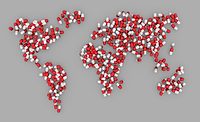Data Shows Rise in Positive Test Rates for Workplace Illicit Drugs

Organizations in the United States that tested employees for drugs saw a 9.3% jump in the number of positive drug tests for illicit drugs in the general workforce, to 4.7% in 2014 from 4.3% in 2013, according to data from Quest Diagnostics.
The Quest Diagnostics Drug Testing Index (DTI) also shows that overall positivity for oral fluid and hair drug tests, representing approximately 1.1 million tests, increased between 2013 and 2014 in the general U.S. workforce.
“American workers are increasingly testing positive for workforce drug use across almost all workforce categories and drug test specimen types. In the past, we have noted increases in prescription drug positivity rates, but now it seems illicit drug use may be on the rise, according to our data,” said Dr. Barry Sample, Director, Science and Technology, Quest Diagnostics Employer Solutions. “These findings are especially concerning because they suggest that the recent focus on illicit marijuana use may be too narrow, and that other dangerous drugs are potentially making a comeback.”
"The increases in illicit drug positivity in employment drug testing should get employers and policymakers to take notice of the serious risks these drugs create for productivity, health and safety,” said Robert DuPont, MD, former Director of the National Institute on Drug Abuse (NIDA). “Many of these substances are clearly associated with impaired physical and cognitive functions. This analysis by Quest Diagnostics suggests that illicit drug use among workers is increasing broadly for the first time in years in the United States. Public and private employers might want to consider revisiting existing substance abuse policies to ensure that they are taking the necessary precautions to protect their workplace, employees and businesses.”
The Quest Diagnostics Drug Testing Index analyzed urine, oral fluid and hair drug tests performed by Quest Diagnostics workplace drug testing laboratories across the United States in 2014. Test results are examined according to three categories of workers: employees with private companies (general U.S. workforce); employees subject to federal drug testing rules, including safety-sensitive employees such as truck drivers, train operators, airline and nuclear power plant workers (federally-mandated, safety-sensitive workforce); and a combination of both groups (combined U.S. workforce). Quest Diagnostics has analyzed annual workplace drug testing data since 1988.
Marijuana continues to be the most commonly detected illicit drug, according to the Quest Diagnostics Drug Testing Index. Marijuana positivity in the general U.S. workforce increased 14.3 percent (2.4% in 2014 vs. 2.1% in 2013). By comparison, marijuana positivity in the same workforce category increased 5 percent between 2012 and 2013. In the safety-sensitive workforce, marijuana positivity increased 6 percent (0.71% vs. 0.67%) between 2013 and 2014, compared to 5.6 percent between 2012 and 2013. The steady increase in the marijuana positivity rate is consistent with findings from other data sources, such as the National Survey of Drug Use and Health (NSDUH).
Quest researchers also analyzed urine drug test data for the U.S. workforce from two states with recreational marijuana-use laws. In Colorado and Washington, the marijuana positivity rate increased 14 percent (2.62% vs. 2.30%) and 16 percent (2.75% vs. 2.38%), respectively, in the general U.S. workforce between 2013 and 2014, roughly parallel to the national average of 14.3 percent. By comparison, the marijuana positivity rate increased 20 percent and 23 percent in Colorado and Washington, respectively, in the general U.S. workforce between 2012 and 2013, compared to the national average of 5 percent.
“We were surprised that marijuana positivity increased at about the same rate in Colorado and Washington as the rest of the United States in 2014, particularly given the sharp increases in the marijuana positivity rate in both of these states in the prior year,” said Dr. Sample. “It’s unclear if this data suggest a leveling off in marijuana use in these particular states or if some other factor is at work. We also find it notable that the national marijuana positivity rate increased as much as it did in 2014, and question if this means that people are more accepting and therefore more likely to use marijuana recreationally or for therapeutic purposes than in the past even in states where marijuana’s use is not clearly sanctioned by state laws. This will be an important area of continued analysis given the national debate about the legality and health impacts of recreational and medicinal marijuana use.”
The Quest Diagnostics Drug Testing Index analysis showed steady increases in workplace positivity for cocaine in the general U.S. workforce over the past two years, reversing a prolonged period of decline. The positivity rate for cocaine in urine tests increased by 9.1 percent (0.24% vs. 0.22%) between 2013 and 2014. Urine drug tests account for the vast majority of cocaine drug tests. The positivity rate also increased in oral fluid and hair specimens, by 30.6 percent and 13.0 percent, respectively, year over year.
Continuing a multi-year upward trend, amphetamines use – specifically the use of methamphetamine – showed an increase across both urine and oral fluid drug tests.
General U.S. workforce data in urine drug tests showed a 7.2 percent year-over-year increase in amphetamines positivity in 2014 compared to 2013 (1.04% vs. 0.97%). In the general U.S. workforce, methamphetamine positivity in urine drug tests increased 21.4 percent (0.17% vs. 0.14%); the positivity rate for oral fluid methamphetamine tests increased 37.5 percent (0.33% vs. 0.24%). Across all specimen types, the positivity rate for amphetamines is now at its highest levels on record and the positivity rate for methamphetamine is at its highest level since 2007.
Amphetamines describe the category, or drug class, that includes both prescription amphetamine drugs like Adderall® and methamphetamine, an illicit drug often known for being produced in clandestine labs. They are a class of central nervous system stimulants that cause increased energy and alertness followed by exhaustion as the effects wear off.
The positivity rate for 6-acetylmorphine, or 6-AM, a specific marker for heroin, doubled in the general U.S. workforce between 2011 and 2014 (to 0.031% in 2014 vs. 0.015% in 2011).
“Our DTI data mirrors research from the National Drug Intelligence Center which also shows that heroin use has increased markedly in recent years. While overall prevalence is low, the escalation in the detection of the 6-AM metabolite indicates heroin use may be growing,” said Dr. Barry Sample. “With the high costs associated with prescription opiates, some drug users may be turning to comparatively cheaper alternatives like heroin.”
http://www.questdiagnostics.com/home/physicians/health-trends/drug-testing
Looking for a reprint of this article?
From high-res PDFs to custom plaques, order your copy today!








